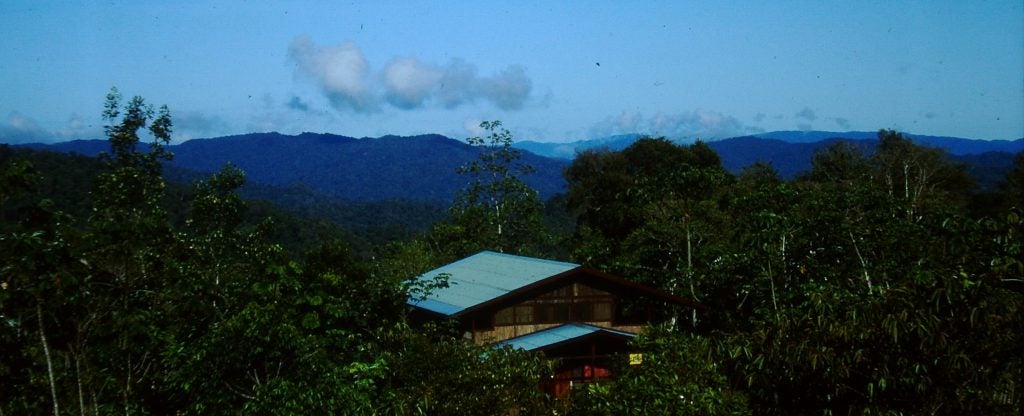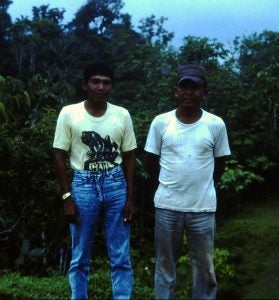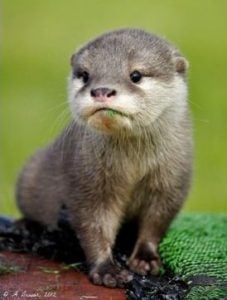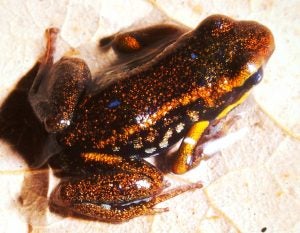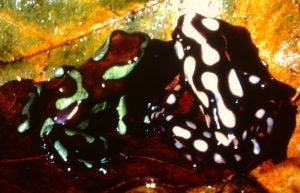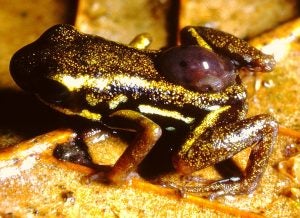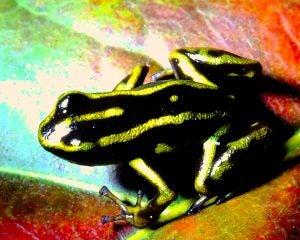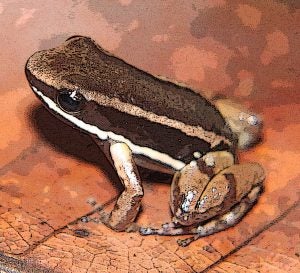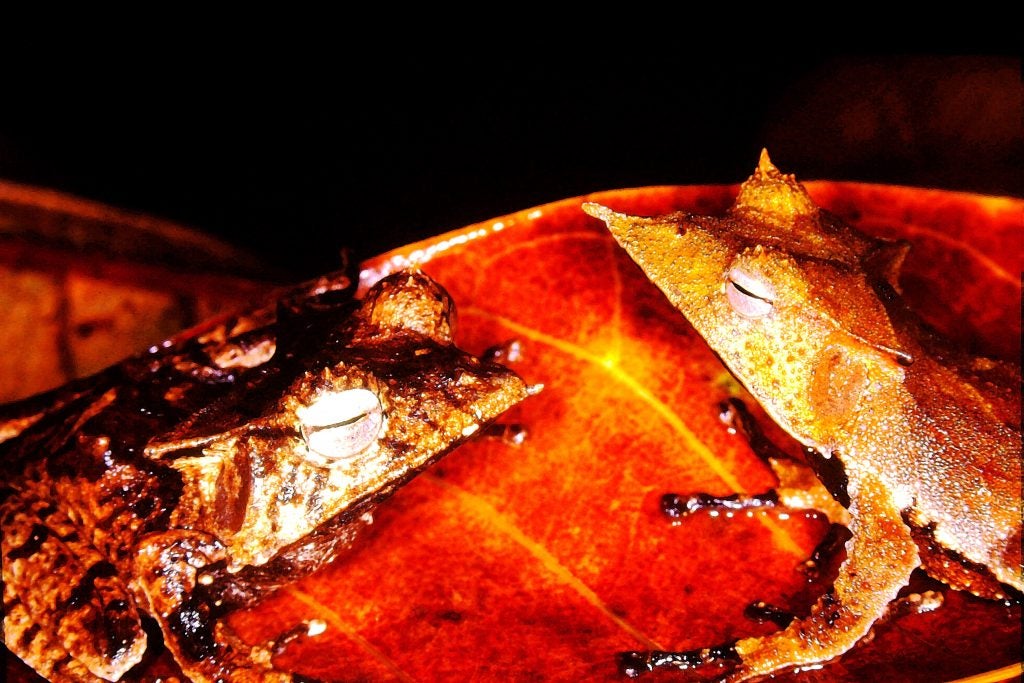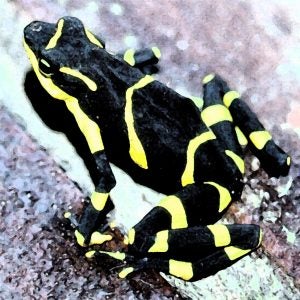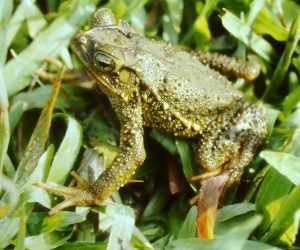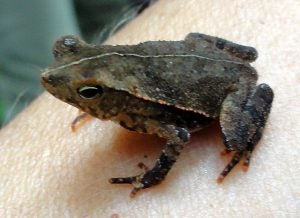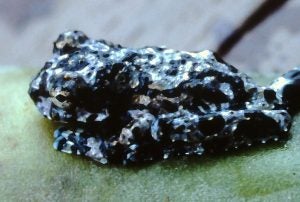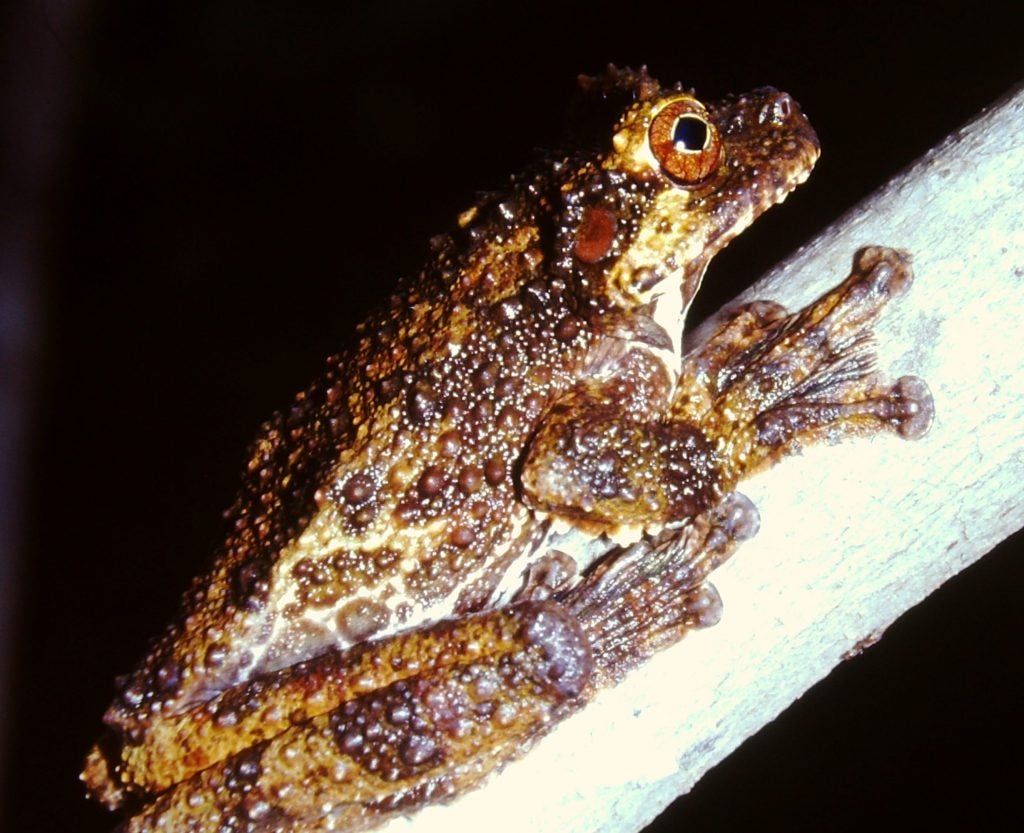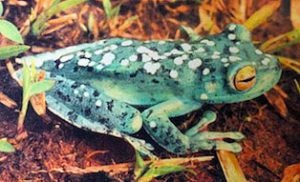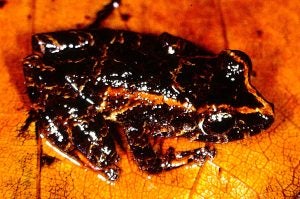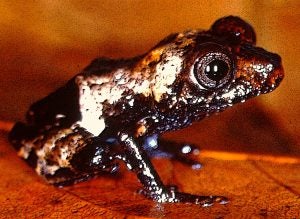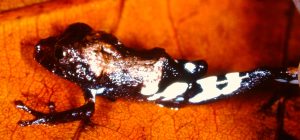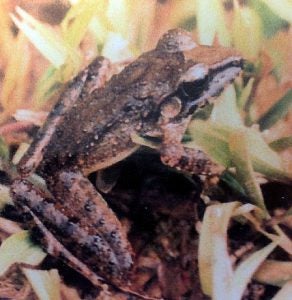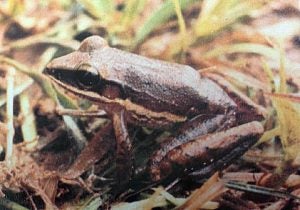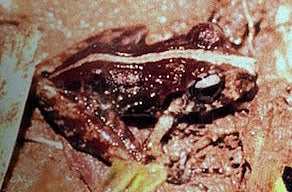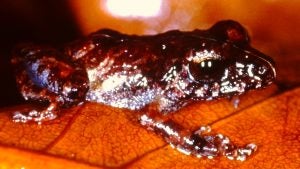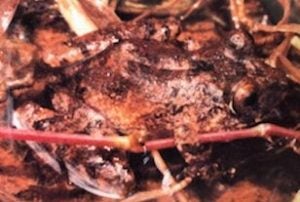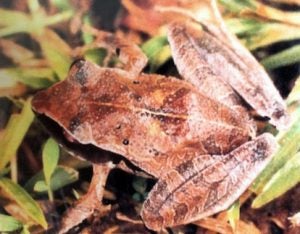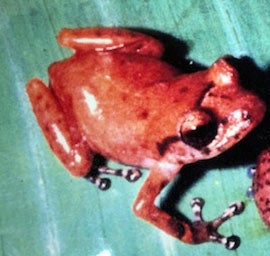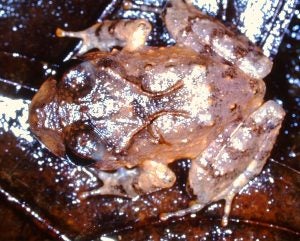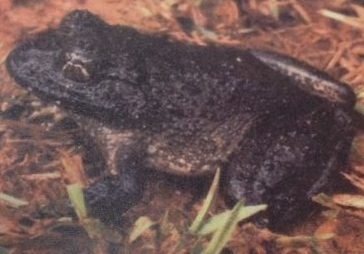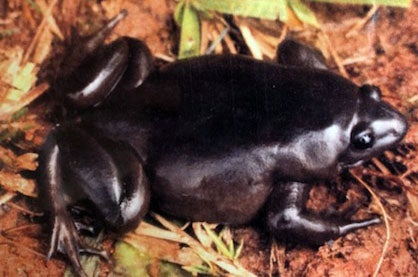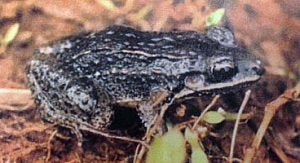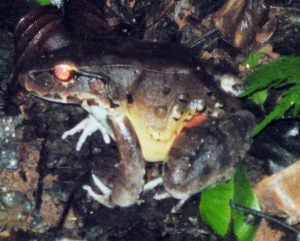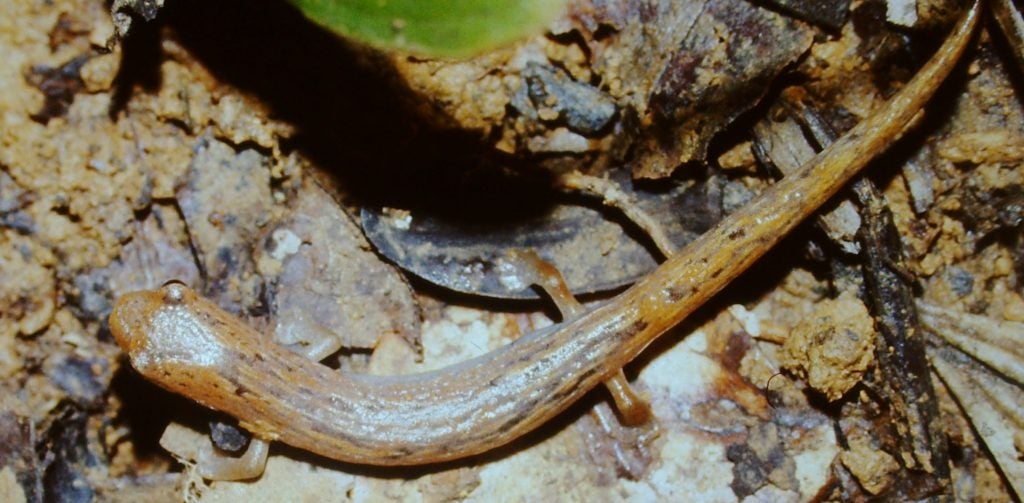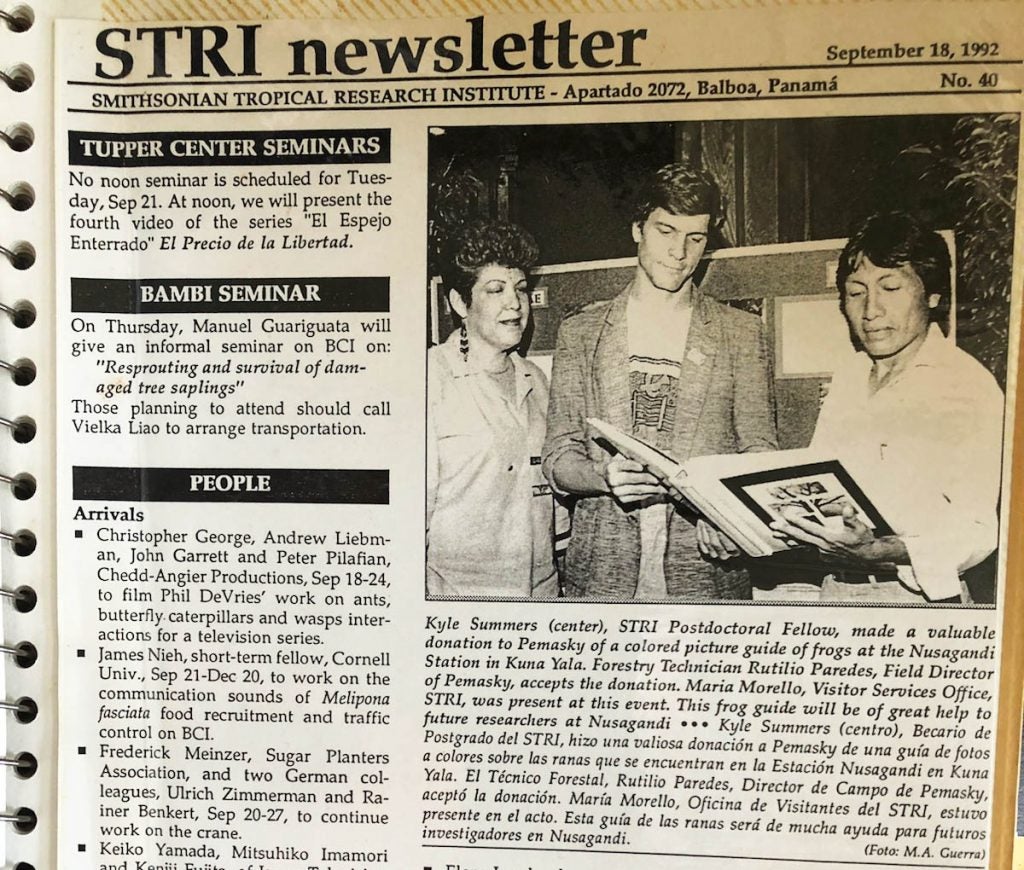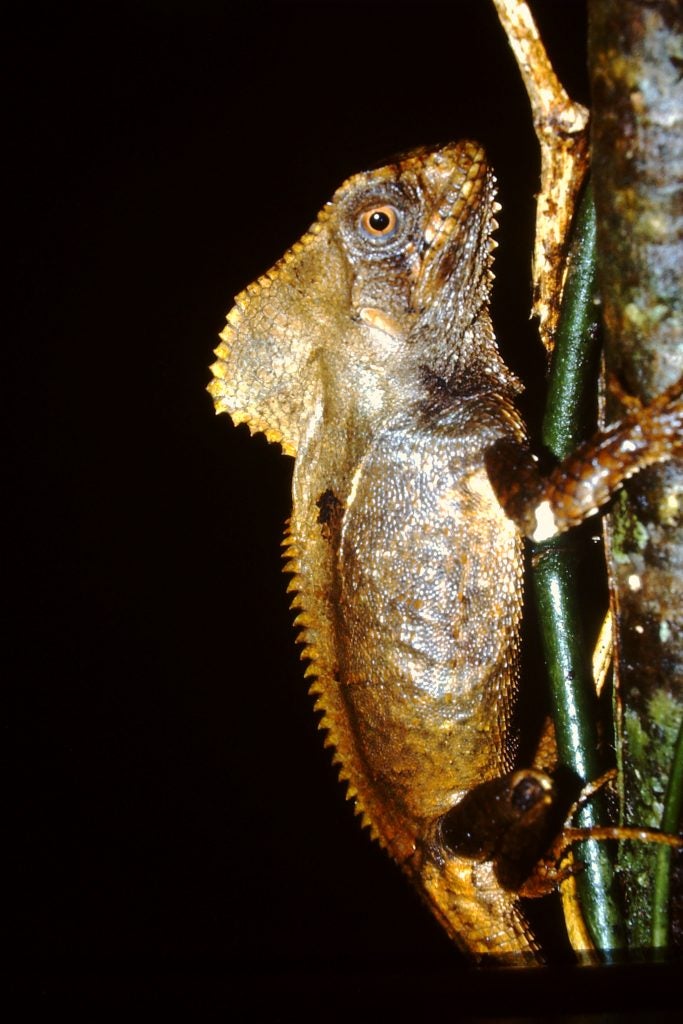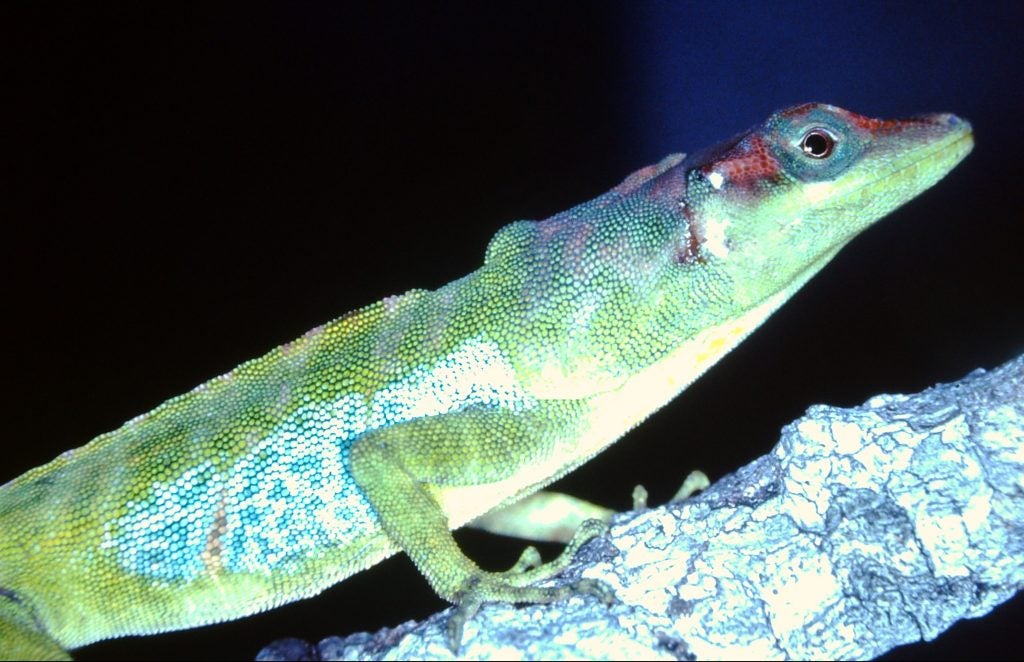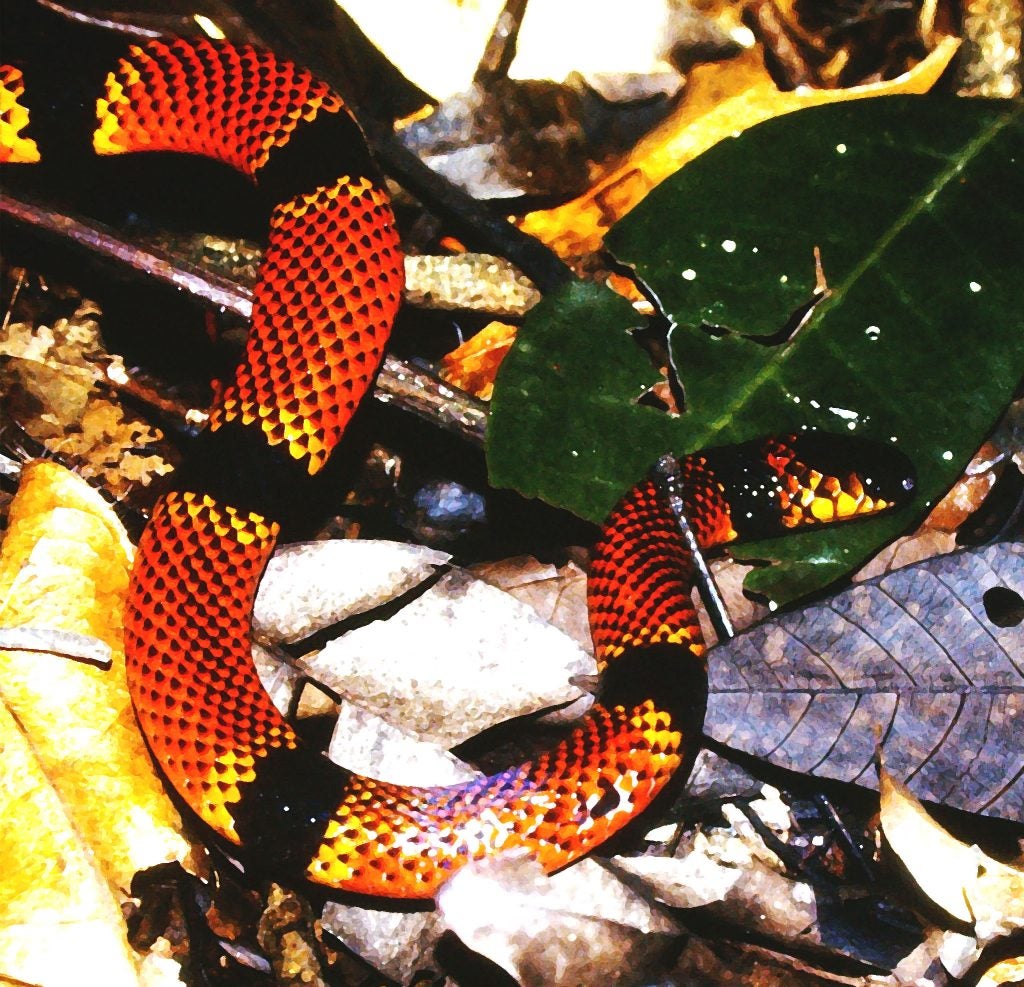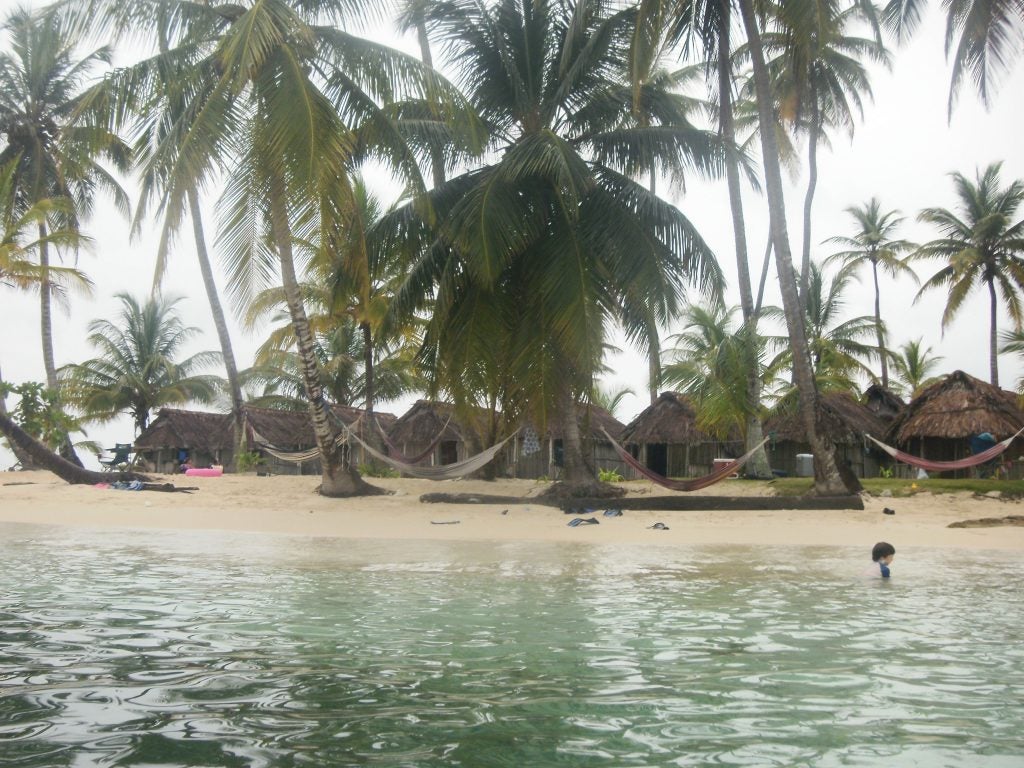Nusagandi is a reserve in the mountains of the Comarca of San Blas in eastern Panama, which is the home of the Guna tribe. The Guna are related to the Embera, indigenous to the Choco region of Colombia and the Darien Gap between Colombia and Panama. Most of the Guna live on an archipelago of islands in the Caribbean (the San Blas Archipelago), but some live on the mainland coast, and Nusagandi Reserve Station is in the mountains above the village of Carti, and was supervised by several caretakers during my stay (Photo: Jorge y Humberto).
The invasion of Panama by US forces happened before I worked at Nusagandi, but the station played an interesting role, involving one of my STRI advisors (Dr. Nancy Knowlton, currently the Director of Marine Sciences at the Smithsonian Institution). When the US forces invaded, Manuel Noriega directed the armed forces personnel (Guardia Nacional) under his command to seek out scientists at the STRI marine research station in San Blas to use as hostages.
Nancy Knowlton and her six-year old daughter, along with a number of other STRI scientists and staff, were taken prisoner at the station, taken to Carti, and force marched at gun point into the mountains to the Nusagandi Field Station. The station manager was somewhat shocked when this group showed up at his doorstep, but he nonetheless dutifully ask them all to sign the registration book. This is a picture of the guest registration book that all of the hostages had to sign when they arrived at the station. Fortunately for the hostages, the invasion was over quickly and the radio broadcasts made it clear that Noriega would be in no position to negotiate using hostages (Noriega himself had holed-up in a church where he was surrounded by US forces). As the broadcasts made it more and more clear that Panama was under US control, the soldiers guarding the hostages gradually slipped away, until there was only one left… He wisely followed in his companion’s footsteps, and the hostages were left alone. By the time US forces came to Nusagandi, all the guardia were gone, leaving the bewildered (and relieved) hostages behind.
I went to work at Nusagandi as a STRI postdoc in 1991. My time at Nusagandi was less stressful than that of the hostages, but I did have a wonderful yet very sad experience during my stay there. As a prelude, I should mention that I have always had a special fondness for otters. Since first seeing sea otters on the Big Sur coast of California as a child, I have been fascinated by these amazing creatures. I have been lucky to see river otters (Lutra lutra) in a few of the field sites I have worked at in Central America, but unlucky with my attempts to see giant otters in Amazonia. In the Yasuni reserve in Amazonian Ecuador, I frequented places where family groups of giant otters had been seen, but never managed to catch a glimpse of them. On one day I went to one spot (nobody home), only to return to the station to be told a group had just swum byummer Then another researcher returned from the spot I had just been too, reporting that he had just seen the group there! Oh well… Some of my students have been luckier. For example, my former student Sea McKeon’s email address starts with “fifthotter”, because when he worked at Manu park he was able to swim with a family group of giant otters in the lake there. It is probably wise to swim with giant otters in that lake (if they will let you), because the black caimans there are huge and have been known to eat people. Giant otters in groups are more than a match for even large caiman (giant otters vs. caiman).
One day while visiting a stream a short hike from the station, I found an abandoned otter pup mewing and crawling along the shore. The photo at left is from the web – unfortunately I lost my photos of the pup I found at Nusagandi. I watched the pup for the rest of the day from a distant, hidden point, in case its mother might come and find it, but this did not happen, so I came and picked up the little pup. It is amazing how quickly this little otter accepted me as its savoir. After a brief hiss, it spent a few minutes sniffing me, and then decided I was a friend and meekly accepted being picked up and placed in a backpack. I returned the next day and again let the pup crawl along the banks for several hours, hoping the mother might return to reclaim her pup, but she did not come. And so I adopted the little pup and she came to live with me at the station. This little otter pup was the most loving and affectionate animal I have ever known. She loved nothing so much as cuddling, and would become very agitated if left alone (I kept her in a large cardboard box to keep her out of trouble when I was in the field). She was extremely curious and playful, and would get her little nose into everything I was doing (rolling around on top of my notebooks was a favorite activity, especially if they were open and I was working on them). For what seemed like months but was actually only a few weeks, I took care of this wonderful little otter. I contacted a mammal expert at STRI about what I should do, and he recommended that I bring the pup in to Panama City for vaccinations, as otter pups are very susceptible to diseases commonly contracted by young dogs and cats, like distemper. I took her to a vet clinic in Panama City, where they administered the vaccines. Unfortunately the shock to her system was too much for her, and she died the during the night after she received the vaccines. This was one of the saddest experiences of my life. I buried her in the forest in Gamboa, and I still visit her grave when I go back to Gamboa, all these many years later.
My research focus at Nusagandi was to study several species of poison frogs, particularly Ranitomeya minuta (formerly Minyobates minutus) and Dendrobates auratus. Ranitomeya minuta is a tiny frog with a dull reddish color. I was curious as to how this species could coexist with Dendrobates auratus, since they both placed their tadpoles in phytotelmata.
Denrobates auratus is widespread but the Nusagandi population is an unusual brown and white morph (see photo). Experiments on tadpoles of the two species (matched for size) demonstrated that D. auratus tadpoles always kill and eat R. minuta tadpoles. So why didn’t D. auratus competitively exclude their smaller relative?
Surveys on pool use by the two species and experiments on growth rates in different sized pools revealed that M. minutus tended to put their tadpoles in much smaller pools than D. auratus, and that D. auratus tadpoles did not grow or survive well in the small pools that R. minuta tadpoles were able to thrive in. Hence, in spite of the fact that D. auratus tadpoles are voracious predators, R. minuta does quite well (in fact, it is abundant)! See this reference (Summers & McKeon 2004) for further details.
Another tiny species of poison frog lives at Nusagandi: Ranitomeya fulgurita. This species is about the same size, but has distinctive stripes, unlike R. minuta. It is not clear why, but this species is much less common than R. minuta. I have never seen the two species interact, and I have not found R. fulgurita tadpoles.
Nusagandi is also home to a number of non-toxic members of the dendrobatid and aromobatid frog families, such as Allobates talamancae, Silverstonia flotator and Colostethus inguinalis. These “rocket frogs” are active diurnal frogs that engage in some of the same complex parental behaviors seen in the toxic dendrobatids.
Nusagandi was a wonderful place to work. The mountains are beautiful and the climate is moderate. The diversity of life is astounding, especially for frogs and birds. As a side project during my stay at Nusagandi, my assistants and I set up grids in the forest and sampled them for frogs at regular intervals (Nusagandi survey). Hopefully these data will provide baseline data for future studies of the amphibian communities of this region.
One of my favorite frogs at Nusagandi is Hemiphractus fasciatus. This species has a large, arrowhead-shaped head and a huge gape, giving them a bizarre, prehistoric aspect. They also have bony spikes growing from the lower jaw that can serve as fangs, allowing this frog to deliver a painful bite, even to humans. They are voracious eaters, and seem to specialize on frogs, readily swallowing smaller frogs that come within reach. They also have direct development, with the eggs developing into tiny froglets while glued to the mothers back.
One of the most striking species of frogs at Nusagandi is Atelopus limosus, usually found near streams. This gorgeous frog is a member of the toad family and shows the bright, contrasting coloration typical of the aposematic species in this genus. Unfortunately, populations of Atelopus throughout Central and South America have undergone severe declines. I am unsure of the current status of this species at Nusagandi. At the time I worked at Nusagandi (in 1991) it seemed fairly common along the larger streams near the station.
Other bufonids that occur in this area include Rhinella alata, Bufo coniferus, and the ever-present Bufo marinus. Rhinella alata is a fascinating species, because it comes in so many different (yet cryptic) colors and patterns, with various forms of “leaf veins” and “fungal spots”, apparently mimicking leaves and leaf damage. Recent research has revealed evidence for negative frequency dependent selection by predators on these color patterns (link).
Another fascinating frog that occurs at Nusagandi is Ecnomiohyla miliaria. This frog appears to be a canopy specialist, and so is not commonly seen by ground bound humans. The juvenile at left fell out of the canopy near my foot, wrapped in a struggle with a giant bullet ant (genus Paraponera). Unfortunately the ant stung the frog repeatedly before I could separate them, and the frog died shortly after I took this picture. The picture below is of a full grown adult found at a later date.
The natural history and ecology of this species is poorly known, probably because of its arboreal habitats and the difficulty of finding or observing individuals. However, observations do indicate that (similar to some frogs in Asia) these frogs can extend the extensive webbing between their toes and parachute from branch to branch in the canopy.
The most common tree frog at Nusagandi is Boana rufitela. This is a medium-sized tree frog that is fairly abundant near forest ponds and swampy areas. Like the gladiator frog, this species has a sheathed spine that may play a role in male-male combat.
The most commonly seen frogs on our sampling grids were (not surprisingly) rain frogs of the genus Pristimantis, Craugastor and Strabomantis.
Pristimantis gaigei is an interesting rain frog, as it appears to be a mimic of Phyllobates lugubris, from the clade of poison frogs with the most deadly alkaloid (batrachotoxin). There has been some debates about this, and not everyone accepts this explanation for the presence of the orange-red stripes characteristic of this species, but they are clearly visible and it is not clear why else they would have evolved.
Pristimantis cruentus is a commonly seen rain frog, with the cryptic yet highly variable coloration that is characteristic of many rain frog species. At first glance, the stripes on this individual may seem to stand out much like those on P. gaigei (above), but they are of a duller color that matches the background, and P. cruentus doesn’t have the dark blackground coloration found in P. gaigei.
Pristimantis pardalis (the leopard robber frog) is less commonly seen, but is a striking looking frog, with what appear to be flash colors that can been clearly seen when the leg is extended. This appears to be a case of a deimatic (flash) display, designed to be flashed at predators at the last minute, presumably startling them and giving the frog a momentary chance to escape.
Craugastor raniformis and Craugastor talamancae look very much alike, but can be distinguished by the coloration on the back of their thigh, which is brown with cream flecks in C. raniformis, but uniformly pigmented in C. talamancae.
Another similar looking pair of rain frogs are Craugastor crassidigitus and Pristimantis ridens. These two small rain frogs can often be found hiding in the leaf litter.
Other rainfrogs include Pristimantis cerasinus and Craugastor gollmeri. As you can see, this is a great spot for rain frogs! Perhaps this is not surprising, as it rains alot!
There are also several species of Strabomantis, such as the beefy, warty Strabomantis bufoniformis and the compact Strabomantis laticorpus.
Microhylids are also common at Nusagandi, although they are hard to find. This large Nelsonophryne aterrima was incredibly calm while being handled and photographed, right up until the point where it saw its chance and bolted for the forest while we were trying to get another picture – it used its powerful legs to jump like it was shot out of a gun and was gone before we knew what was happening!
Another common frog in this area is Leptodactylus labialis, although they are hard to see because they tend to call from beneath dense vegetation. Their large cousin, Leptodactylus savagei, is also present, and is a voracious consumer of other frogs. Given their large size, pretty much no other frog is safe, other than toxic species or the large bufonids like Bufo marinus (itself a voracious predator) or Bufo coniferus.
Nusagandi is also home to that ubiquitous frog (and star of many research papers), Engystomops pustulosus.
We also, very occasionally, found salamanders clambering about in the undergrowth at night. I think the fellow below is a Bolitoglossa cuna (although perhaps this should be changed to B. guna, now that that the Cuna (or Kuna) have changed their name to Guna)?
After my stay at Nusagandi, I made a frog field identification book, which I donated to PEMASKY, the Guna organization that manages the Nusagandi Reserve.
Nusagandi is also home to a number of beautiful lizards and snakes. This forest lizard (genus Enyalioides) is rarely seen but spectacular.
Another impressive forest lizard is Corytophanes, which has a striking casque-shaped head. These lizards rely on being cryptic to avoid predators, and are also extremely good at remaining absolutely still. In fact, when you catch them, they seem to go into a kind of trance, and remain perfectly still even if placed on their back. I caught one fellow on the Ina Igar trail and propped him up on a branch. When I returned two hours later, he was still there, in the exact same position!
One day I was fortunate to find a male of an undescribed species of anole (females of this as-yet-unamed species had previously been found further northwest on the Caribbean slope of Panama further north). This species has now been described in the literature (Hulebak et al. Phyllomedusa 6(1) June 2007).
There are also some beautiful snakes to be seen at Nusagandi, like this large coral snake.
Obviously Nusagandi is an amazing place to visit for anyone who likes amphibians and reptiles. It is also a fantastic spot for birding. A large variety of rare and beautiful species can be seen here. Mixed flocks containing a spectacular array of gaudily-ornamented birds are frequently seen, even from the main road. Frequently observed species include the violet-crowned woodnymph, black-throated trogon, rufous motmot, keel-billed and chesnut-mandibled toucan, red-lored parrot, black-crowned antshrike, ocellated antbird, spot-crowned antvireo, slaty antwren, plain xenops, brown-capped tyrannulet, blue crowned manakin, red-capped manakin, fulvous-vented euphonia, king vulture, long-tailed tyrant, masked tityra, goden-hooded tanager, emerald tanager, scarlet-thighed dacnis, blue dacnis, shining honeycreeper, among many others. This is the only place I have ever seen a rufous-vented ground cuckoo, which basically just walked right up to me while I was sitting near the trail, then walked away.
As I mentioned, most of the Guna live on islands in the San Blas Archipelago off the coast. This archipelago has long been the focus of research by marine biologists based at STRI. STRI used to have a research station right in the archipelago. Unfortunately, due to some bad behavior by some foreigners running a business in the archipelago (totally unconnected to STRI), the Guna decided to disallow foreign enterprises in their comarca, and STRI was forced to abandon their field station there in 1998. Some STRI research is still being done in San Blas, but it is more difficult to work there these days. For me, as a herpetologist working in the rainforest, San Blas was a welcome getaway location that I could visit after I got tired of being in the field. Lying in the sun on a beautiful tropical island, eating fresh seafood, and snorkeling over gorgeously luxurious coral reefs filled with gaudy reef fish is my idea of paradise, and I used to burn with envy of my friends who worked at the station, with their perfect tans and frequent scuba trips all over the reefs. Of course, if you do too much of anything it becomes a routine chore, so perhaps my envy was misplaced.
